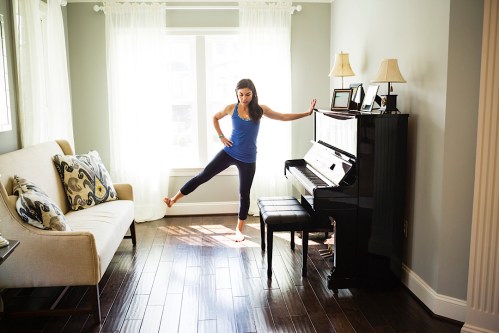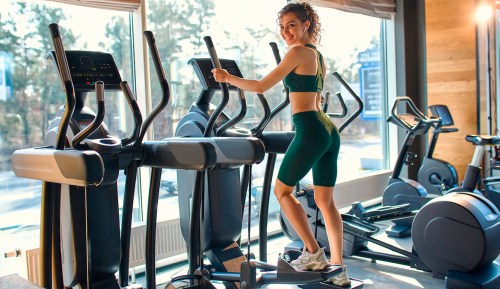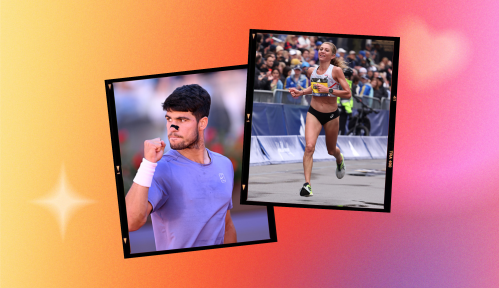Our editors independently select these products. Making a purchase through our links may earn Well+Good a commission
Spending Just 5 Minutes on Your ‘Foot Core’ Can Stabilize Your Body From the Ground Up
Your foot core can have effects all the way up to your hips, so strengthening it can make your body more resilient.

Pretty much anyone who’s ever stepped inside a gym has been told how important it is to strengthen your abdominal core. But there’s another core you should be paying (maybe even more) attention to: your foot core.
Experts in This Article
That’s the argument that Christopher MacDougall and Eric Orton make in their new book, Born to Run 2: The Ultimate Training Guide, a training-based follow-up to MacDougall’s industry-changing Born to Run from 2009. It’s full of bite-sized, practical advice, like form skills, healthy recipes, tips for running with your dog, and, yes, why you might want to run in less-cushioned shoes (the original book led to a minimalist revolution, followed by a maximalist backlash). The overarching theme that connects it all is learning to run in a way that brings us joy.
And in order to love running, it has to feel good—while not leaving us injured. A strong foot core can be key to staying injury-free, argue MacDougall and Orton. “We often have been maybe over-directed toward our abdominal core, but from a running standpoint, any athletic standpoint, hey, our foot core is more important,” MacDougall tells Well+Good. Having a strong foot core means not only having a stable connection to the ground, he says, but also an awareness of how we use our feet.
Whether you’re a runner or not, this can have effects throughout your body, says Orton. That’s because activating our feet creates better stability all the way up through the ankles, knees, and hips, allowing us to more easily tap into the major muscles groups that help us move, like the hamstrings, quads, and glutes.
One chapter of Born to Run 2 is dedicated to three simple exercises that can help you do that, and we’ve shared them here. The skills may not seem like much at first glance, but they’re surprisingly effective. “They work very quickly,” says MacDougall.
The key is to do them regularly, for just a few minutes a day. MacDougall recommends using them as a warm-up before heading out the door, and also admits he and his wife slip them in whenever they’re waiting for the coffee to brew or in line at a store. “Once you get it into your system,” he says, “it becomes this kind of really rewarding little habit and challenge that you want to indulge in all the time.”
Here are the three exercises, excerpted from the book:
1. One-leg barefoot balance
- Balance on one foot, on your forefoot, on a hard surface with the heel a little elevated so you feel nice and strong at the arch.
- Use a wall or chair or partner to help you stabilize when needed.
Note: This isn’t a calf raise exercise, with up and down movement with the foot. There’s no movement, just stabilizing.
How many: 30–90 seconds per foot, or until you fatigue.
Pay special attention to: Where you feel it. Some may struggle with strength in their feet; others may be stronger in their feet and feel the most fatigue in their calves or glutes.
(You’re gonna feel it where you need it,” Orton tells Well+Good. “It’s where your weakest link is.”)
2. Side lift
- Balance barefoot on your right forefoot using a wall or chair or partner to help you stabilize.
- Keeping your right leg straight, raise your left leg sideways (think of half a pair of scissors opening).
- Raise your left leg only as high as you can while maintaining level hips, and then go back to the start position.
Note: This is a stabilizing exercise for the stance leg, not a range-of-motion exercise for the moving leg.
How many: 15–25 reps, then repeat with the opposite leg.
3. Knee lift
- Balance barefoot on your right forefoot using a wall or chair or partner to help you stabilize.
- Keeping your right leg straight, raise your right heel slightly.
- Now, lift your left knee in front of you as high as you can, and then go back to the start position. Keep your movements slow and controlled.
- The focus is on the stance leg, not the moving leg.
How many: 15–25 reps, then repeat with the opposite leg.
Exercises excerpted from Born to Run 2: The Ultimate Training Guide by Christopher McDougall and Eric Orton. Published December 6, 2022 by Alfred A. Knopf, an imprint of The Knopf Doubleday Publishing Group, a division of Penguin Random House LLC. Copyright © 2022 by Christopher McDougall and Eric Orton.










